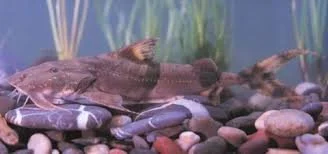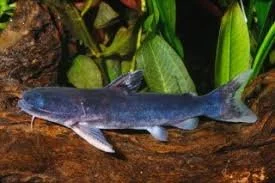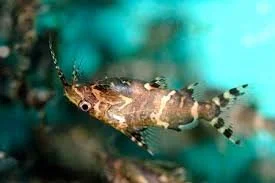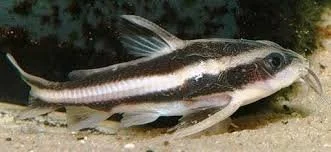 Image 1 of 1
Image 1 of 1


Synodontis eupterus (1 in)
The Synodontis eupterus, commonly known as the featherfin squeaker or the featherfin catfish, is a popular freshwater aquarium fish. Here's a care guide to help you provide the best environment for your Synodontis eupterus:
1. Tank Setup:
Tank Size: A tank size of at least 55 gallons is recommended for adult Synodontis eupterus, as they can grow to around 12 inches (30 cm) or more.
Substrate: Use fine sand or smooth gravel as a substrate to prevent injury to their delicate barbels.
2. Water Parameters:
Temperature: Maintain a water temperature between 75°F to 82°F (24°C to 28°C).
pH Level: Keep the pH level between 6.5 and 7.5.
Water Hardness: Aim for a moderate water hardness level, around 5-15 dGH.
3. Filtration:
Synodontis eupterus appreciate well-filtered water with moderate to strong water flow.
Use a quality aquarium filter to maintain water quality, and perform regular water changes to keep nitrate levels low.
4. Diet:
Provide a balanced diet that includes high-quality sinking pellets, flakes, and frozen or live foods like bloodworms, brine shrimp, and daphnia.
They are omnivores, so offering a variety of foods will help meet their nutritional needs.
5. Tank Mates:
Synodontis eupterus is generally peaceful but may be territorial, especially when housed with similar species. Avoid keeping them with overly aggressive tank mates.
Compatible tank mates include other peaceful community fish that won't bother or outcompete them for food.
6. Hiding Places:
Provide hiding places such as caves, PVC pipes, or driftwood, as Synodontis eupterus appreciate having retreats to feel secure.
7. Lighting:
Use subdued lighting as these catfish come from areas with dense vegetation and subdued light.
8. Behavior:
Synodontis eupterus is a nocturnal species, so they may be more active during the night. They are also known to be somewhat shy, especially in brightly lit environments.
9. Breeding:
Breeding Synodontis eupterus in captivity can be challenging. It often involves simulating the rainy season by adjusting temperature and water conditions. Spawning can occur in caves or other secluded areas.
10. Health Considerations:
Keep an eye on their barbels; if they become damaged or show signs of infection, check water parameters and address any issues promptly.
Quarantine new fish before introducing them to the main tank to prevent the spread of diseases.
Regular monitoring, proper feeding, and maintaining good water quality are essential for the health and well-being of Synodontis eupterus. Always research and be prepared for the specific needs of any fish species you plan to keep.
The Synodontis eupterus, commonly known as the featherfin squeaker or the featherfin catfish, is a popular freshwater aquarium fish. Here's a care guide to help you provide the best environment for your Synodontis eupterus:
1. Tank Setup:
Tank Size: A tank size of at least 55 gallons is recommended for adult Synodontis eupterus, as they can grow to around 12 inches (30 cm) or more.
Substrate: Use fine sand or smooth gravel as a substrate to prevent injury to their delicate barbels.
2. Water Parameters:
Temperature: Maintain a water temperature between 75°F to 82°F (24°C to 28°C).
pH Level: Keep the pH level between 6.5 and 7.5.
Water Hardness: Aim for a moderate water hardness level, around 5-15 dGH.
3. Filtration:
Synodontis eupterus appreciate well-filtered water with moderate to strong water flow.
Use a quality aquarium filter to maintain water quality, and perform regular water changes to keep nitrate levels low.
4. Diet:
Provide a balanced diet that includes high-quality sinking pellets, flakes, and frozen or live foods like bloodworms, brine shrimp, and daphnia.
They are omnivores, so offering a variety of foods will help meet their nutritional needs.
5. Tank Mates:
Synodontis eupterus is generally peaceful but may be territorial, especially when housed with similar species. Avoid keeping them with overly aggressive tank mates.
Compatible tank mates include other peaceful community fish that won't bother or outcompete them for food.
6. Hiding Places:
Provide hiding places such as caves, PVC pipes, or driftwood, as Synodontis eupterus appreciate having retreats to feel secure.
7. Lighting:
Use subdued lighting as these catfish come from areas with dense vegetation and subdued light.
8. Behavior:
Synodontis eupterus is a nocturnal species, so they may be more active during the night. They are also known to be somewhat shy, especially in brightly lit environments.
9. Breeding:
Breeding Synodontis eupterus in captivity can be challenging. It often involves simulating the rainy season by adjusting temperature and water conditions. Spawning can occur in caves or other secluded areas.
10. Health Considerations:
Keep an eye on their barbels; if they become damaged or show signs of infection, check water parameters and address any issues promptly.
Quarantine new fish before introducing them to the main tank to prevent the spread of diseases.
Regular monitoring, proper feeding, and maintaining good water quality are essential for the health and well-being of Synodontis eupterus. Always research and be prepared for the specific needs of any fish species you plan to keep.






